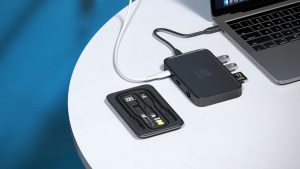Desk setups these days are like jungles. Keyboards. Mouses. Multiple monitors. Lights. Stream Decks. The amount of cabling that comes with putting together your dream computer setup is enough to make the Amazon rainforest blush. Just looking at all of those cables scattered about like vines can be anxiety-inducing, not to mention somewhat dangerous. There’s no reason to work and play in such chaos, though.
With the following cable management tools, you can tame the digital wilderness of your desk and turn your setup into the calming space you need to get stuff done.
Get Cable Tidy Boxes

These nifty boxes are meant to house your surge protectors and multi-sockets. Though they’re primarily marketed for child-proofing purposes, they can be a godsend if you have a few power strips lying around underneath your desk. Not only can they keep your toes safe, but cable tidy boxes can also help you route your power cables. Most will come with several exit holes for your power cables to avoid them getting tangled and to be more easily joined together with ties.
Speaking of which…
Make Copious Use of Cable Ties

Cables are like wild animals. Leave them to their own devices and they’ll just end up going all over the place. Cable ties will allow you to reign them in and bundle them together nice and neat. We specifically recommend using velcro cable ties as they will allow you to easily reconfigure your setup. Zip ties are more permanent in nature and can be quite a hassle to cut off when you want to move things around. Velcro ties do the job just as well. In fact, you can even buy them in large coils that allow you to cut them up into whatever length you need. You can even find color-coded Velcro ties if you want to divide your cables into distinct bundles.
Leverage Your Gear to Route Cables
Both your furniture and your equipment can actually be used to hide and route cables. Mouse, keyboard, and other desktop cable chaos can be hidden and tied around monitor stands. Cables that drop behind your desk can be tied against its legs. If your keyboard raises up a fair bit, you can pass a few cables underneath it. Even better, if it has an extra USB port, you can plug something into it, say a Stream Deck or mouse. The key principle here is to find ways to hide as much of your cabling as possible behind, under, and around the bigger parts of your setup.
Stick Cable Raceways Under Your Desk
Cable raceways are godsends and we can’t ever have enough. They’re plastic routers that stick onto any surface, including under your table, to pass cables through and keep them out of sight, out of mind. We recommend placing a few under your desk as it will allow you to get a lot of those pesky floor vines away from your toes. It’ll also give you the option of routing cables from the sides of your desk instead of just behind. As a bonus, you’ll find it a lot easier to clean underneath your desk.
Attach a USB Hub or Two
It seems like every computer and desk accessory these days has a USB cable attached to it. We’re not just talking about your standard input devices here. Mug warmers, lights, and fans are just the tip of the desktop accessory iceberg and they’re all tetherable through USB. Restricting yourself to just the ports behind your computer tower can become a cable management nightmare fast. By sticking a USB hub or two underneath your desk, you’ll give yourself a lot more cable routing flexibility. You’ll also have more than a few extra ports to work with.
Taming the wild and unruly jungle of your cables takes a bit of upfront work. It’s best to plan things out initially before committing to buying any products. Consider how much movement freedom you’ll need with some of your gear and how often you’ll need to make adjustments. With a bit of time and planning, you’ll be able to get your cables under control and game in peace.






